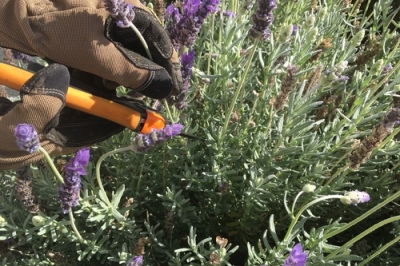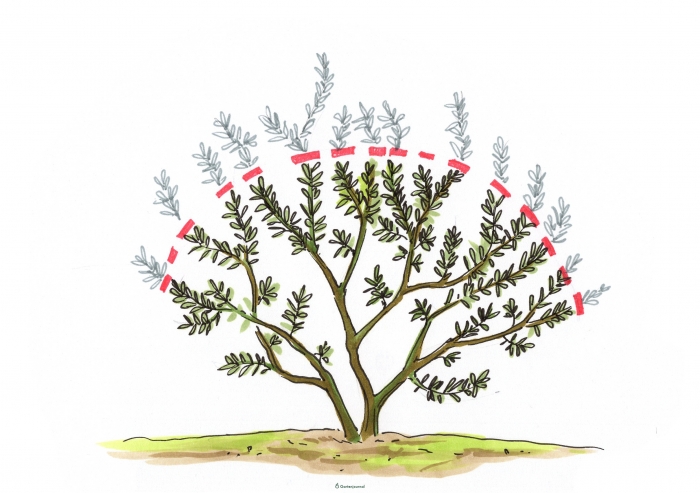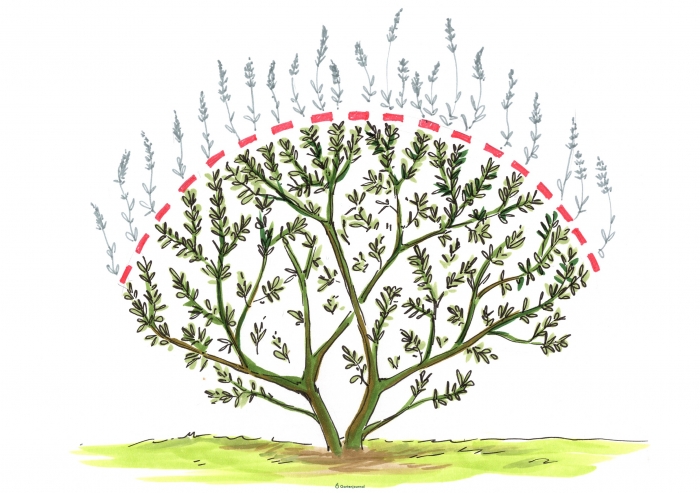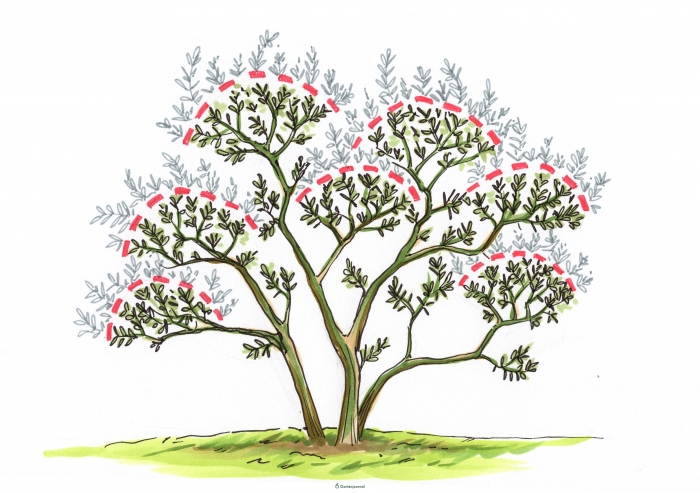Mediterranean blossom magic and shapely growth are guaranteed if you prune your lavender courageously every year. When and how to properly prune the floral icon from the Mediterranean is explained in detail in this tutorial.

Pruning care on lavender is primarily aimed at promoting the growth of herbaceous shoots and preventing progressive lignification. It is no cause for alarm if herbaceous sections freeze back in winter. Lavender bears its fragrant flowers on shoots of this year. A vigorous pruning in spring clears the way for new shoots with numerous flower buds and leaves by summertime.
Contents
- 1 Pruning types and dates
- 2 Habitat protection also applies to half-shrubs
- 3 Cut lavender on planting day
- 4 Postpone pruning when planting in autumn
- 5 Harvest lavender flowers half open
- 6
- 7 The best time is in February when the weather is frost-free.
- 8 Pruning tools – quality is the key
- 9 Frequently asked questions
- 10 Should freshly planted lavender be pruned or not?
- 11 How can I permanently prevent lavender from balding?
- 12 How tall does true lavender (Lavendula augustifolia) grow?
- 13 Is lavender poisonous?
- 14 Due to construction, I need to transplant my lavender. When and how can I do this?
- 15 The 3 most common pruning mistakes
- 16 Author
Pruning types and dates
North of the Alps, lavender does not form a stable perennial framework. Shapely, compact and flower-rich growth depends on the Mediterranean half-shrub not becoming woody and senescent. Pruning care starts on planting day and continues steadily with two annual pruning appointments. Tricky, but not impossible, is rejuvenating an old, neglected lavender shrub. Sensible pruning methods and dates for a lavender in top form are summarized in the following table:
| Cut type | Goal / Occasion | Best date |
|---|---|---|
| Plant cut | strong branching, shapely growth | in the spring after planting |
| Maintenance pruning | Prevent lignification, maintain shape | End of February/beginning of March |
| Maintenance cut | clean out withered flower panicles | shortly before the end of the flowering period (middle/end of July) |
| Rejuvenation pruning | revitalize senile lavender | End of February/beginning of March |
| Topiary | Shape lavender ball | End of February/beginning of March |
Habitat protection also applies to half-shrubs
Responsible lavender gardeners ignore date recommendations for spring and summer when low-reaching pruning is involved. Native bird species, such as warblers, yellowhammers, nightingales, and robins, prefer to lay their nests near the ground. The feathered garden inhabitants do not disdain a dense lavender as a nesting place. Pruning would have fatal consequences for the already endangered birds. Section 39 of the Federal Nature Conservation Act emphasizes the urgency of protective measures with a grace period from March 1 to September 30. Maintenance pruning is permitted in exceptional cases, such as cleaning out wilted flowers.
Cut lavender on planting day
Best sowing and planting time for lavender is in spring. Starting in March or April, when the ground has thawed, you can sow the seeds in a sunny location. Ready-bought or windowsill-prepared plants set in the bed in early/mid-May, when late frosts are no longer to be feared. In the last operation, lavender plants receive their first pruning. Here’s how to get the perfect planting cut:
- Cut back all shoots by one-third or one-half.
- Cut visibly weak young plants vigorously
- Cut vigorous young plants little
Prune the outer shoots a little shorter to create a harmonious, hemispherical shape. If it is a flowering lavender, it will receive a maintenance pruning after the flowering period. Cut off withered flower panicles no later than the beginning of August. Underneath, non-flowering shoots should be shortened by 2 to 3 centimeters.
Postpone pruning when planting in autumn
Far from its native regions in southern Europe, lavender is sensitive to frost. This applies primarily to its herbaceous plant parts. If you have decided on an autumn planting date in the garden bed, please postpone pruning until the following spring. Pruning just before winter increases the risk of massive frostbite and even total failure. This does not apply if young lavender can spend the cold season in frost-free winter quarters.
Cut vigorously in the spring
As the short excursion into botanical properties teaches us, lavender blooms on shoots of this year. Just before growth begins is the best time to pave the way for fresh shoots to reach the light. In mid to late February, subject lavender in beds and containers to this maintenance pruning:
- Cut back shoots by one-third to two-thirds.
- Caution: do not cut into the old, bare wood
- Thin out completely shortened, dead shoots at the base.
As illustrated below, spring pruning on lavender is limited to the leafy area. The reason for this important premise is that the Mediterranean semishrub does not sprout from old wood, or sprouts very hesitantly.
Pruning care effectively stops progressive woodiness when you shorten your lavender by 10 to 15 inches each spring starting in its second year of standing.

Tips
Lavender clippings are much too good for the compost pile. Use the shredded shoots as mulch in the garden bed. As litter in a cage or hutch, the fragrant clippings repel pests. If dried lavender bundles are lying around the house, ants will give your home a wide berth. Throw heavily woody shoots into a bonfire to enjoy the aromatic scent.
Prune lavender in summer
As the summer flower festival draws to a close, lavender receives a maintenance pruning. Withered flower panicles should be removed now so that all the growth energy goes into a second shoot that will protect the plant in winter. Here’s how to properly prune lavender in July:
- The best time to do this is during bloom.
- Cut off wilted shoot tips above the first, opposite pair of leaves
- Loosely tie potted lavender to cut off the top third
Figure below illustrates that summer pruning is limited to withered shoot tips. If the maintenance pruning of a lavender hedge or a whole flock of space-consuming plants is dedicated, do the job power- and time-saving with a hedge trimmer.

Harvest lavender flowers half open
Just before their full bloom, lavender flowers develop their full potential. Are you growing the plant to use its flowers for hot and cold dishes or preparation as tea? Then harvesting should be done in the half to three-quarter open stage. At this time, essential oils and healing ingredients are at maximum levels. Fully bloomed lavender is a picturesque feast for the eyes, but has already passed its zenith as a fragrant and medicinal plant.
When gardeners skip the annual pruning of lavender, the Mediterranean flowering beauty turns into a senescent, bare thicket. Young shoots make themselves scarce, as do fragrant lipped flowers and lanceolate leaves. This is no reason to bother with an energy-sapping clearing of the deep-rooted plant. Via the path of a gradual rejuvenation, you awaken the floral spirits. Important for a successful course is a good external measure, because into the old wood you should not even a senescent lavender. This is how you do it right:
First stage
In February, cut back all green leafy shoots by half, as illustrated below. In this way, also prune green broom-like heads. Only bare shoots that are visibly dead from base to tip should be cut off at ground level. A generous portion of compost with horn shavings will additionally stimulate the growth.
Second stage
A combination of pruning, ideal weather conditions, and a little luck will allow new shoots to sprout on shabby branches in the following period. Give growth free rein during the summer. In February of the following year, the second stage is on the agenda. How to succeed:
Derive senescent, woody branches to a young side shoot in the lower area.
Apply loppers or saw at the fork of old and new wood
Ideally, cut a small distance into the old wood so as not to injure the young hopeful. Any remaining cones will dry out in the following months and can be removed. A supplementary supply of nutrients in the form of leaf compost, horn shavings or liquid fertilizer supports further growth.

Rejuvenation pruning – wake-up call for sleeping eyes.
Planned rejuvenation pruning upends the floral doctrine that lavender will not sprout from old wood. If the first stage of pruning is limited to the green area, a prominent sap buildup occurs below the cut. This process optimizes the chances that dormant eyes in old wood will come to life and sprout. Dormant eye, in gardening parlance, refers to buds that are in a dormant state.
Shape lavender balls
Lavender’s distinct pruning tolerance allows it to be topiary, comparable to boxwood or thuja. As a decorative border or flower-rich fence, lavenders shine as bright blue spheres. The design stroke of genius is achieved by a vigorous pruning. How to prune lavender into a ball shape:
The best time is in February when the weather is frost-free.
- From the second year, cut back all shoots to 2 to 3 cm short cones
- Leave shoots a little longer inside than outside
- Important: at least 2 to 4 leaves must remain standing
The shorter you cut a lavender ball in the spring, the more compact and clearly defined you work out the round shape. Of course, this is at the expense of the summer blooms. If you prefer the happy medium, shorten the shoots more moderately. The sphere will be less prominent. In return, lavender puts on a blue flower dress.
Pruning tools – quality is the key
With the right tools, you’ll complete lavender pruning with flying colors. The semishrubs tend to become woody, which can make pruning adult plants a feat. If a scissor blade lacks sharpness, ragged pruning wounds are inevitable, which brings pathogens into the picture. We’ve looked over the shoulders of lavender experts to unearth the ideal tool for perfect pruning for you:
- Single lavender: one-handed garden shears from Okatsune, available for small, normal or large hands.
- Lavender hedge: two-handed hedge shears from Okatsune with shock-absorbing handles
- Alternative: Rose shears with stainless steel blades from Felco or Fiskars
- Garden shears (19,00€ at Amazon*) of the Japanese manufacturer Okatsune are constructed as bypass shears with blades made of carbon steel. This is a robust material that retains its value and can be ground precisely and very sharply. Hedge shears from the hand of the Japanese master smiths are available in a variety of designs with different lengths of blades and handles.
Frequently asked questions
Should freshly planted lavender be pruned or not?
Young plants grown in pots usually do not require plant pruning. If it is bare-root, we recommend a light planting pruning. Cut back all shoots by a third or half. If you plant lavender in the fall, please postpone planting pruning until early spring, when the main frost period is over.
How can I permanently prevent lavender from balding?
In general, lavender should be cut back deeply each spring as soon as the frost period is over. This measure will largely counteract any stemming of the plant. This is on the premise that the plant is subjected to this pruning care from the beginning. Pruning into the old wood may result in total failure under certain circumstances. In the course of the summer, withered flower shoots are regularly pruned out, which also prevents premature balding on lavender.
How tall does true lavender (Lavendula augustifolia) grow?
Unpruned, true lavender achieves a growth height of 60 to 70 centimeters. This applies to ideal conditions in a fully sunny, sandy-dry and well-drained location. To ensure that the flowering half-shrub already thrives compactly and does not become senescent, you should cut it back sharply every spring to just above the woody area.
Is lavender suitable as a low hedge plant? Which variety is recommended? When and how often should I prune a lavender hedge?
The lavender variety “Siesta” grows more compact and is excellent as a hedge plant. The half-shrubs are cut twice a year. Immediately after flowering, clean out lavender by cutting off all wilted flowers in late July/early August. Perform central topiary and maintenance pruning in early spring, just before growth begins.
Is lavender poisonous?
Lavender is non-toxic. The plant is rich in essential oils and other valuable ingredients that make it a proven medicinal, fragrant and edible plant. Lavender is widely used as a base for perfumes, washing powders, oils and essences. In beekeeping, the flowers are highly prized because they are rich in nectar. As an ingredient in natural medicines, lavender relieves insomnia and restlessness. A colorful array of beneficial attributes makes this Mediterranean plant an ideal candidate to beautify the family garden.
Due to construction, I need to transplant my lavender. When and how can I do this?
Best time to relocate is in April and May, after the frost period ends. The traditional fall date is risky for frost-sensitive lavender, which may not root in time before the first frost. The more root volume the plant can take with it, the more promising the procedure will be. Then cut back all the shoots by a third, so that the plant invests its strength in vigorous root growth. Water abundantly and regularly, because a good water supply is the key after transplanting.
My lavender is a year old and still blooming now in November. Should I cut off the wilted stems now or wait until spring?
There is nothing wrong with cutting off the wilted flower panicles in November. As long as the foliage remains on the lavender, you can’t go wrong. Please do not do the main pruning until February, cutting all shoots back by a third or half. The important thing to remember with all pruning on lavender is that you do not cut into the old wood.
The 3 most common pruning mistakes
Pruning care spoils the enjoyment of lavender, as does pruning too deeply or too late. To save you from typical mistakes in pruning lavender shrubs, take a look at the following table. The three most common pruning mistakes with damage patterns and tips for prevention should be familiar to amateur gardeners:
| Cutting error | Damage pattern | Prevention |
|---|---|---|
| never cut | premature senescence | cut back vigorously every spring |
| cut into the old wood | puny growth to total failure | always prune in the herbaceous area |
| too late cutting date | Frost damage, failure of flowering | cut in March, clean out in July |
Tips
Dried lavender flowers in a scented sachet exude Mediterranean flair in the linen closet. To dry, place the flowers in a shady, well-ventilated place. In summer temperatures, the process takes no more than two to three days. When the petals rustle softly when touched, they are completely dry.

